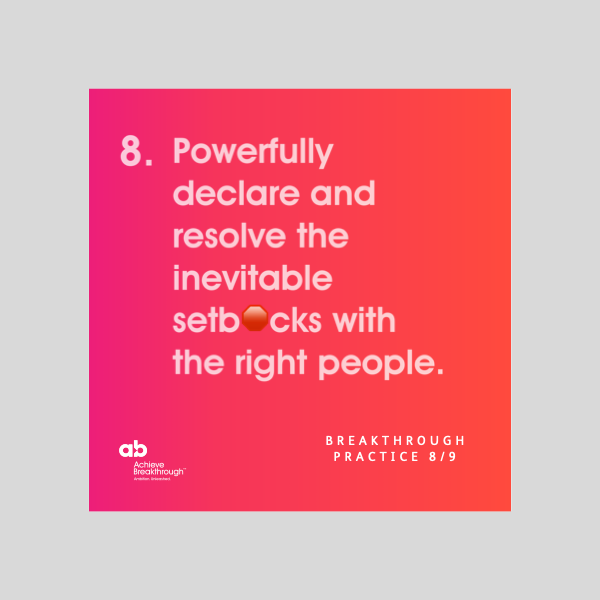Breakthrough Thinking Practice 8: Powerfully declare and resolve the inevitable setbacks with the right people
Leadership Blog | 4 minute read

Written by Achieve Breakthrough

---------------------------------------
So far in this blog series we've discussed seven of our nine breakthrough practices:
---------------------------------------
Breakthrough Thinking Practice 8: Powerfully declare and resolve the inevitable setbacks with the right people
Leaders are beginning to come to terms with the fact that setbacks are inevitable. Intellectually, at least. ‘It’s okay to fail’ is a good starting point, but that attitude alone is not enough to reconnect us to the sense of high possibility that a breakthrough commitment requires.
In principle, we know that if we’re going to take a car on the road, we can’t drive it forever without needing new parts. Too often, though, we’re still letting setbacks lower our expectations of how far we can travel.
When the wheels fall off in our organisation, we’re faced with a choice.
We can go down the path of least resistance – ignoring the problem, justifying it or assigning blame – ultimately lowering our expectations of what’s possible.
Or we can acknowledge the breakdown, declare it and resolve it with the right people.
How to fix a breakdown and move onto a breakthrough
Step 1: Declare the breakdown and commit to resolving it
We’ll admit it. Even though our coaches hold us to high account in this area, we still sometimes struggle as an organisation to declare breakdowns.
It’s the work of a lifetime for any company to perfect breakdown resolution, since it doesn’t compute with how people are wired. When faced with a problem of any kind, a psychological reaction is inevitable, and we all have reactive tendencies that are triggered when things go wrong, no matter how free-to-fail our cultures are. So first off, it’s worth letting yourself off the hook and remembering that no one finds this easy.
The faster we declare breakdowns, the faster we can move to fix them. But people are rarely so pragmatic. If, for instance, someone is overwhelmed with their workload, it might seem obvious to outsiders that they should ask for help. But when you’re the one struggling, it’s not so easy. More subtly, leaders can hesitate to declare a breakdown because they don’t want to show up in a way that questions their competency or optimism.
But once the issue is out in the open, you can commit to resolve it and stay true to your original leadership goal.
Step 2: Separate facts from interpretations
After you get beyond the judgement that your setback shouldn’t have happened, you can allow yourself to have some curiosity around it.
Breakdowns and problems are real, frustrating and sometimes devastating. But no matter how big or small, to get clarity on a way forward we need to separate the facts of ‘what’s actually happened’ from our interpretations.
So, you’ve missed a deadline. That might be a fact. But the follow-on interpretations: “I’m rubbish,” “I’ve let everyone down”, "they'll think I'm unreliable" - are opinions, but not facts. The quicker you can circumnavigate the self-doubting and self-accusing little voice, the more likely you are to see all the choices you have and get back on the pathway to your goal.
Step 3: Reveal the background commitment
The breakdown is usually only the tip of an iceberg. Underneath might be a huge mass of ice.
When we sense there is a problem, or we realise head-on that we've got one, it's usually because we're committed to something bigger that wasn't immediately obvious. The setback reveals why we were working towards a goal in the first place, and what the real goal is. A setback reveals what we're really committed to.
For example, the setback might be being late, but the background commitment is to showing up well at work and getting a promotion. The lateness is a setback, that makes us realise how important our reputation is. The breakdown itself is in relation to our reputation, not the momentary lateness.
Another setback could be missing a deadline because we have a family event to attend. Being chased on the deadline makes us realise that whilst we don't want to let our colleagues down, we're more committed to our family gathering and how work has become overwhelming in recent months. The breakdown that's revealed could be a work life balance concern, and our commitment to working hard but making time for other things.
It's important to take notice of our setbacks as they help us uncover what we're really committed to and what's getting in the way of achieving our real goals.
Step 4: Get clear on what’s missing and essential
Once you’re clear on the breakdown and the cause, you need one more thing. Namely, clarity on what’s missing and essential for you to press on towards a breakthrough.
You might need to create a new process or reevaluate the budget assigned to a core project. You might need to get input from those closer to the coalface or you might want to bring in external expertise. You might want a conversation with your manager about how you're working. Or your organisation might need to reimagine the way you measure key performance indicators.
Step 5: Take action
Once you're clear on what action is missing and essential to resolve the breakdown, you can go ahead; have the necessary conversations and be proactive in resolving the problem. Looking for the inevitable setbacks and being curious about them, rather than avoiding the problem, is key to getting your real commitments back into action.
Now you can keep blazing a trail with sharper tools and a renewed sense of purpose. If you’ve followed the steps, your breakthrough will still be in your sights, and if anything, it’ll be closer and more tangible than before.
by Izzy Elvery
--
Looking to create an impossible future? Get in touch to explore how we can help you ignite your ambitions.
Published 16/08/2022
Subscribe by Email
Achieve more breakthroughs. Get expert leadership ideas, insights and advice straight to your inbox every Saturday, as well as the occasional bit of news on us, such as offers and invitations to participate in things like events, webinars and surveys. Read. Lead. Breakthrough.
Tags
- Attracting talent
- Behaviour change
- Blended Learning
- Breakthrough Thinking
- Business partnering
- Career planning
- Change management
- Collaboration
- Communication
- Competitive strategy
- Creativity
- Decision making
- Developing middle management
- Developing millennials
- Developing talent
- Employee engagement
- Entrepreneurship
- High performing teams
- Hiring
- Human Resource Management
- Innovation
- Leadership development
- Learning technology
- Managing people
- Managing uncertainty
- Managing yourself
- Mergers & Acquisitions
- Mindset
- Motivating people
- Negotiation
- Organisational culture
- Organisational development
- Organisational values & purpose
- Performance management
- Productivity
- Programme Management
- Retaining talent
- Strategic thinking
- Strategy
- Strategy execution
- Succession planning
- Team development
- Work-life balance
Related posts
Leadership Blog
Leadership burnout: Expanding bandwidth to thrive through complexity
Achieve Breakthrough | 16/12/2025
Leadership Blog
What triggers you as a leader, and how to work with it?
Achieve Breakthrough | 09/12/2025
Leadership Blog
Why it’s impossible to lead with one foot still in your old role
Achieve Breakthrough | 03/12/2025
Leadership Blog
Why a leader’s true value lies in what they enable, not just what they know
Achieve Breakthrough | 25/11/2025
